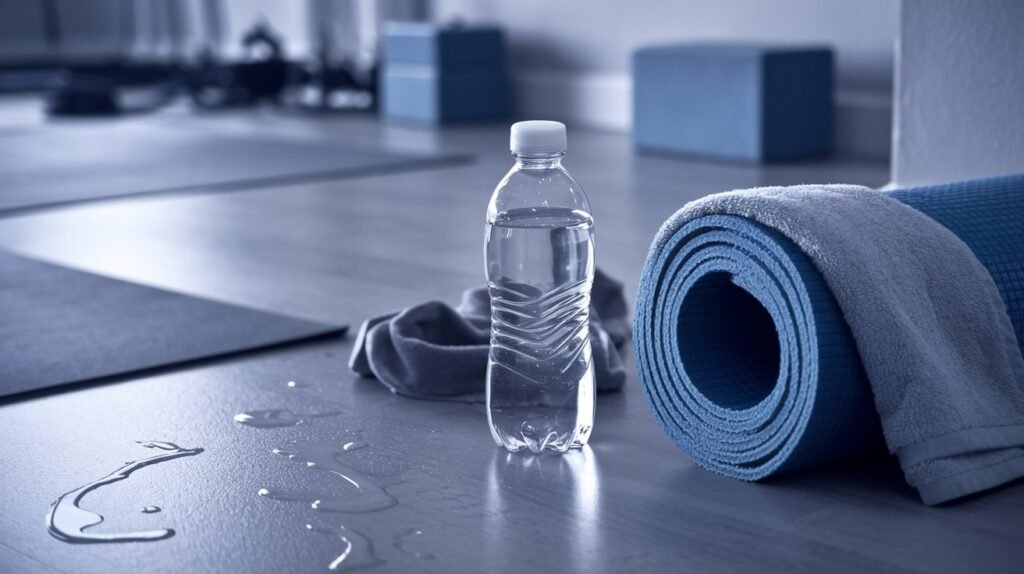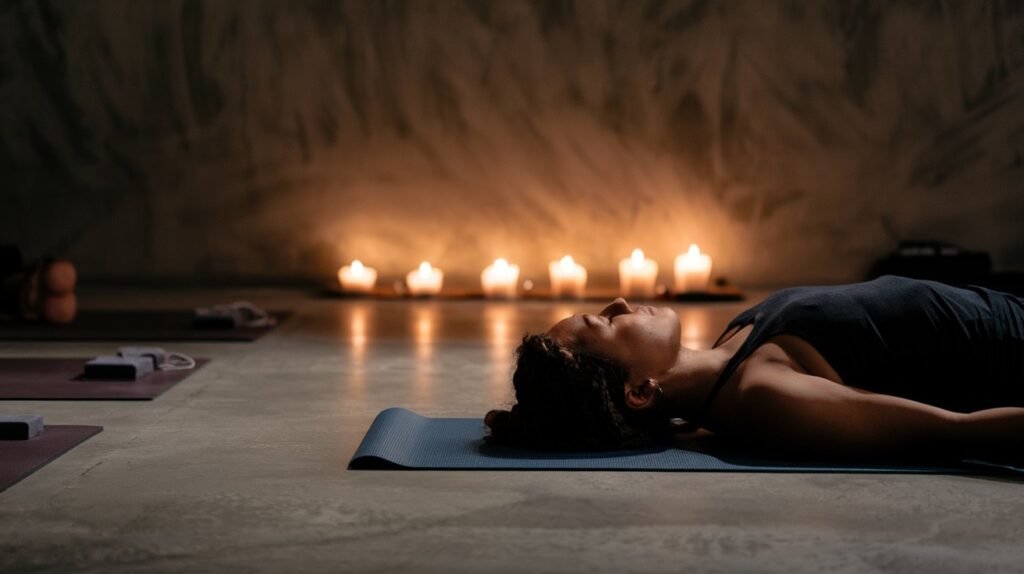Introduction to Hot Yoga
Hot yoga is more than just yoga in a warm room—it’s an intense, transformative practice that enhances the body, mind, and spirit. If you’re looking for a workout that challenges your physical limits while promoting relaxation and mindfulness, hot yoga might be the perfect fit.
This guide will cover everything you need to know about hot yoga, from its origins and benefits to tips for beginners. Whether you’re new to yoga or an experienced practitioner, this article will provide valuable insights into how hot yoga can enhance your health and well-being.
Table of Contents
What is Hot Yoga?

Hot yoga refers to any yoga practice performed in a heated room. While traditional yoga is often practiced in room temperatures, hot yoga is done in temperatures ranging between 80°F to 105°F (27°C to 40°C) with humidity levels of 40% to 60%. This heat creates an environment that mimics tropical climates, helping participants sweat more, increase flexibility, and detoxify their bodies.
One of the most popular forms of hot yoga is Bikram Yoga, a sequence of 26 postures and two breathing exercises, practiced in a room heated to 105°F (40°C) with 40% humidity. However, other styles such as Hot Vinyasa, Hot Power Yoga, and Hot Hatha are also practiced in heated environments, each offering unique benefits and challenges.
Benefits of Hot Yoga
It offers numerous physical and mental health benefits. Below, we break down the science behind these benefits and how it can positively impact your life.
1. Improved Flexibility
One of the most significant benefits is the increased flexibility that comes from practicing in a heated room. The warmth helps loosen muscles, allowing for deeper stretches and improved range of motion.
Statistics: A 2013 study published in the Journal of Strength and Conditioning Research found that participants who practiced yoga in a heated environment showed a significant improvement in hamstring, shoulder, and lower back flexibility compared to those who practiced at room temperature.
| Study Parameters | Hot Yoga Group | Room Temperature Yoga Group |
|---|---|---|
| Improvement in Flexibility | 23% increase | 10% increase |
2. Detoxification Through Sweating
It encourages heavy sweating, which can aid the body’s natural detoxification process. Sweating helps to flush toxins from the skin, including heavy metals and chemicals.
Fact: The skin is the largest organ of the body, and sweating is one of the most effective ways to rid the body of impurities. In hot yoga, the combination of heat and movement increases circulation and enhances the detox process.
3. Enhanced Cardiovascular Health
Hot yoga is a cardiovascular workout, despite being low-impact. The heat increases the heart rate, mimicking the effects of moderate-intensity cardio exercises such as jogging or cycling.
Study: A 2019 study in the journal Complementary Therapies in Medicine found that regular hot yoga practice helped lower blood pressure and improve heart health. Participants who practiced hot yoga three times a week for 12 weeks saw a 10% reduction in their resting heart rate and improved circulation.
4. Stress Relief and Mental Clarity
Yoga, in general, is well-known for its ability to reduce stress, improve mental focus, and promote mindfulness. Hot yoga enhances these benefits by creating a challenging physical environment that requires intense concentration and presence of mind.
Scientific Evidence: A study published in the Journal of Health Psychology found that hot yoga participants reported lower levels of perceived stress and improved mood following their practice.
5. Weight Loss and Increased Metabolism
Practicing hot yoga can help burn more calories than traditional yoga, thanks to the heat and intensity of the movements. The elevated temperature causes the body to work harder to cool down, leading to a higher calorie burn.
Caloric Burn Comparison: According to the American Council on Exercise, an average person can burn up to 500 calories during a 90-minute hot yoga session, compared to 200–300 calories during a regular yoga session.
| Yoga Style | Calories Burned (per 90 minutes) |
|---|---|
| Hot Yoga | 400–500 calories |
| Regular Yoga | 200–300 calories |
Hot Yoga vs. Regular Yoga: Key Differences
To better understand what makes hot yoga unique, let’s compare it to traditional yoga in terms of intensity, environment, and benefits.
| Feature | Hot Yoga | Regular Yoga |
|---|---|---|
| Room Temperature | 80°F to 105°F | Room temperature (65°F to 75°F) |
| Sweating | Heavy sweating due to heat | Minimal to moderate sweating |
| Intensity | High intensity, challenging | Moderate intensity |
| Flexibility Benefits | Enhanced due to heat | Gradual improvement |
| Detoxification | More pronounced through sweating | Limited detoxification effects |
| Calorie Burn | 400–500 calories per session | 200–300 calories per session |
How to Prepare for Hot Yoga

If you’re new, proper preparation is essential to ensure you have a positive experience. Here are some key tips to help you get started.
1. Hydration is Key
The heat and humidity can lead to significant fluid loss through sweat. It’s important to hydrate before, during, and after class to avoid dehydration. Aim to drink at least 16–20 ounces of water in the hours leading up to your session and bring a large water bottle with you to class.
Pro Tip: Electrolyte-rich drinks like coconut water or sports drinks can help replenish lost minerals and keep you hydrated.
2. Wear Breathable Clothing
Choose lightweight, moisture-wicking clothing that allows your skin to breathe and helps evaporate sweat. Avoid heavy fabrics like cotton, which can become uncomfortable when soaked with sweat.
3. Bring the Right Equipment
Most yoga studios will provide mats, but it’s a good idea to invest in a high-quality yoga mat that offers good grip even when wet. You may also want to bring a yoga towel to cover your mat and absorb sweat.
4. Acclimate to the Heat
The heat can be overwhelming if you’re not used to it. Consider attending shorter sessions or arriving early to allow your body to gradually adjust to the warm environment.
5. Eat Light Before Class
Avoid heavy meals before the class, as practicing on a full stomach can lead to discomfort or nausea. A light snack, such as a banana or a handful of almonds, is ideal.
What to Expect During a Hot Yoga Class
When attending your class, knowing what to expect can make the experience more enjoyable. Here’s a step-by-step breakdown of a typical hot yoga session.
1. Arrival and Setup
Most yoga studios recommend arriving 15–20 minutes early. This gives you time to sign in, acclimate to the heat, and set up your mat in a comfortable spot. Studios usually maintain a quiet atmosphere, allowing you to mentally prepare for the practice.
2. The Warm-Up
Classes typically start with a gentle warm-up sequence to ease your body into the movements and prepare for more intense postures.
3. The Main Sequence
The core of the class involves a series of postures, often a set sequence like Bikram Yoga’s 26 poses or a Vinyasa flow. These postures are designed to stretch and strengthen the body while promoting balance and flexibility. The heat will make you sweat profusely, which is part of the detox process.
4. Cool Down and Final Relaxation
After the main sequence, classes end with a cool-down period and Savasana (Corpse Pose), a time for total relaxation and reflection. This is where the mental benefits of hot yoga truly shine, as you allow your body and mind to absorb the practice.
Common Mistakes to Avoid
While hot yoga is a rewarding practice, there are a few common mistakes that beginners should avoid to get the most out of their sessions.
- Skipping Hydration: Drinking too little water before class can lead to dehydration and dizziness during the session.
- Pushing Too Hard: It’s important to listen to your body. While it can be intense, overexerting yourself can lead to injury. Take breaks when needed.
- Wearing the Wrong Clothes: Heavy, non-breathable fabrics can make the experience uncomfortable. Stick to moisture-wicking materials.
- Not Bringing a Towel: You’ll sweat a lot, and without a towel, you risk slipping on your mat.
- Eating a Heavy Meal Beforehand: Yoga on a full stomach can cause nausea and discomfort.
Is Hot Yoga Safe for Everyone?
While it is generally safe for most people, it’s not suitable for everyone. The intense heat and physical demands can be challenging, particularly for individuals with certain medical conditions. People with the following conditions should consult their doctor before starting:
- Heart Conditions: The heat can put extra strain on the cardiovascular system.
- Respiratory Issues: People with asthma or breathing difficulties may find it harder to breathe in a heated room.
- Pregnancy: Some experts advise against practicing it during pregnancy due to the potential for overheating.
- Dehydration: If you’re prone to dehydration or electrolyte imbalances, it may exacerbate these conditions.
Conclusion: Is Hot Yoga Right for You?

Hot yoga is a powerful way to enhance flexibility, detoxify the body, and improve overall health. With the added challenge of heat, it pushes both physical and mental boundaries, leading to significant fitness and mindfulness benefits. Whether you’re looking to lose weight, improve your flexibility, or simply find a new way to relax, it can provide the perfect outlet.
However, it’s important to approach hot yoga with caution, especially if you’re a beginner. Ensure you’re properly hydrated, wear appropriate clothing, and listen to your body throughout the practice.
References
- Tracy, B. L., Hart, C. E., Olson, B. J., & Thomas, S. A. (2013). Yoga in a heated environment improves flexibility in young healthy adults. Journal of Strength and Conditioning Research, 27(2), 483–490.
- Choudhury, B. (2007). Bikram Yoga: The Guru Behind Hot Yoga Shows the Way to Radiant Health and Personal Fulfillment. Harper Collins.
- Hunter, S. D., Dhindsa, M., Cunningham, E., Tarumi, T., Alkatan, M., & Tanaka, H. (2019). The influence of hot yoga on cardiovascular health in middle-aged and older adults. Complementary Therapies in Medicine, 44, 239-243.
- West, J., Ottey, L., Gevirtz, R., & Rasgon, N. (2004). The effects of mindfulness-based hot yoga on perceived stress and well-being. Journal of Health Psychology, 9(1), 69-76.
- American Council on Exercise. (2020). Caloric Burn Rates in Yoga Practices: A Comprehensive Study.




